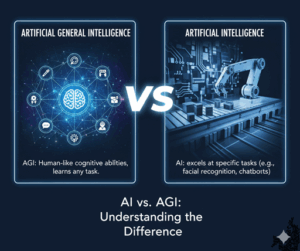Artificial Intelligence (AI) is no longer a futuristic concept—it’s embedded in our daily lives, from voice assistants to fraud detection systems. But as technology evolves, a new frontier emerges: Artificial General Intelligence (AGI). While AI is already transforming industries, AGI promises to redefine the very nature of intelligence itself.
Let’s unpack the difference between these two transformative technologies and explore what they mean for the future of innovation.
What Is Artificial Intelligence (AI)?
AI refers to machines or systems designed to perform tasks that typically require human intelligence. These tasks include:
- Image and speech recognition
- Natural language processing
- Predictive analytics
Most of the AI we interact with today is Artificial Narrow Intelligence (ANI)—systems trained to do one thing extremely well. Think of chatbots, recommendation engines, or self-driving cars. They’re smart, but only within their specific domain.

What Is Artificial General Intelligence (AGI)?
AGI, often called “strong AI”, is a hypothetical form of intelligence that can understand, learn, and apply knowledge across a wide range of tasks—just like a human. Unlike narrow AI, AGI would:
- Solve unfamiliar problems without prior training
- Learn new skills autonomously
- Exhibit creativity, reasoning, and emotional understanding
Imagine a machine that could write a novel, diagnose a disease, and negotiate a business deal—all without being explicitly programmed for each task. That’s the promise of AGI.
Key Differences Between AI and AGI
| 🔍 Feature | Artificial Intelligence (AI) | Artificial General Intelligence (AGI) |
|---|---|---|
| Scope | Task-specific | Broad, human-like capabilities |
| Learning | Requires training data | Learns autonomously |
| Flexibility | Limited to predefined tasks | Adapts to new, unknown tasks |
| Current Status | Widely deployed | Still theoretical |
| Examples | Chatbots, facial recognition | None yet—still in development |
Why It Matters for Einnosys
At Einnosys, we believe in pushing the boundaries of innovation. Understanding the distinction between AI and AGI helps us prepare for the next wave of technological disruption. While AI is already enhancing productivity and decision-making, AGI could unlock entirely new possibilities—from fully autonomous enterprises to machines that collaborate as creative partners.
Looking Ahead
AGI is still a work in progress, but its potential is immense. As researchers inch closer to building machines with human-level cognition, businesses must stay informed and agile. Whether you’re developing smart systems or exploring future-ready solutions, knowing the difference between AI and AGI is the first step toward strategic innovation.
Einnosys is committed to staying ahead of the curve. Let’s build the future—intelligently.
📅 Posted by Dan Wallace on September 10, 2025


